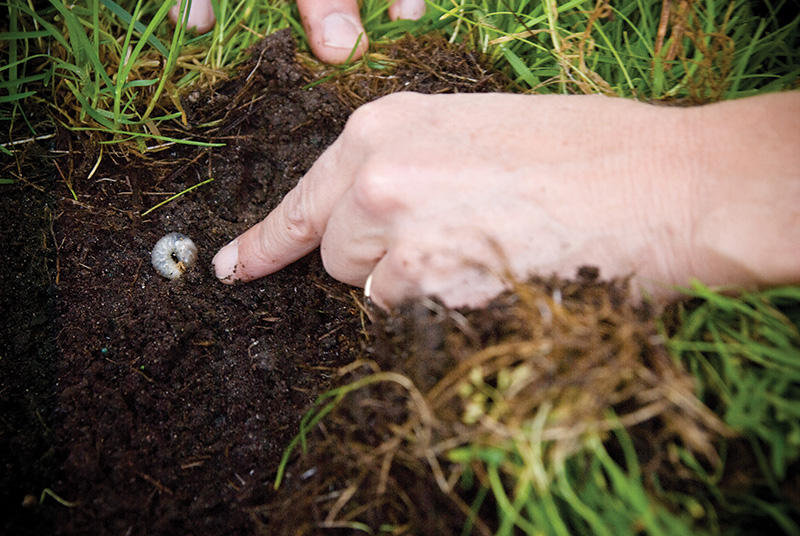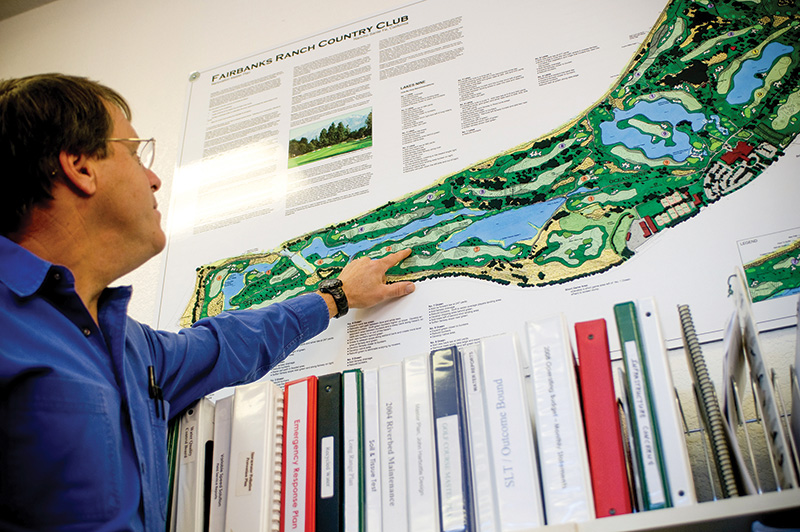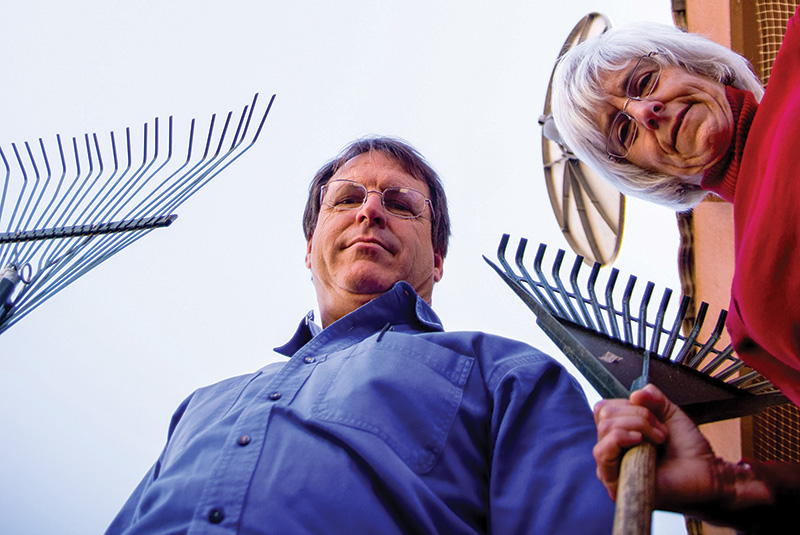
Outstanding Contribution Award winners Larry Stowell, Ph.D., is the plant pathologist and Wendy Gelernter, Ph.D., the entomologist behind PACE Turf, the respected and vast online repository of turfgrass information. Photos courtesy of Larry Stowell and Wendy Gelernter
In the beginning, Wendy Gelernter, Ph.D., and Larry Stowell, Ph.D., weren’t sure if golf course superintendents would take anything the two of them said seriously.
“When we first came out, we were coming out of nowhere,” Gelernter says. “We didn’t have a big university behind us. It was a process earning that credibility, getting people to trust us.”
It would appear they found a way to bridge that credibility gap. There’s no doubt that a collective (deep breath here) 16 book chapters, 46 refereed publications, 72 refereed abstracts, 71 trade publications, two patents, dozens of video podcasts, countless golf course consultations, untold invited presentations and innumerable soils sampled went a long way to that end.
Over a career of some 30 years, the two did more than compile envious CVs, though. Sure, they studied and researched and diagnosed and wrote and presented, but they nurtured, consulted and educated, fundamentally changing the way countless superintendents approach agronomy, whether they know it or not.
“Hopefully some people got the message about how soils work,” Stowell says. “And the idea of using less. You don’t have to spray all the time. That’s really hard for a superintendent to do. It’s really hard to tell someone to withhold a spray application in an environment where they can get fired.”
The two officially retired at the start of this year, but they’ll have one more industry obligation in 2025, when they collect their Outstanding Contribution Award at the GCSAA Conference and Trade Show in their hometown of San Diego.
“It’s a real honor,” Stowell says. “It’s nice, because it lets us reflect a little on what our contribution was. To have people recognize that we tried to do our best … it’s a nice feeling.”

Stowell and Gelernter met while working in the 1980s at Mycogen Corp. before reuniting professionally at PACE Turf in 1995
A Mycogen meet-up
In the beginning, neither Gelernter nor Stowell envisioned a career in turfgrass.
After earning his bachelor’s in agriculture at the University of Arizona, Stowell earned his doctorate in plant pathology, also at the U of A. After a couple of years as a postdoc researcher at the University of California, Davis, he went to work — on crop plants — at Mycogen Corp. as director of its mycoherbicide group. That’s where he obtained two patents on mycoherbicide research innovations.
Gelernter earned her bachelor’s in agricultural science at Cornell University and her doctorate in entomology at the University of California, Riverside. She, too, spent time as a research scientist before heading to Mycogen, first as a product manager, then as director of biopesticide commercial development.
The two met while working at Mycogen and married — “We were the first marriage there, but not the only one,” Gelernter says — but parted ways professionally, if only briefly.
PACE Turf LLC grew out of the consulting business Stowell started in 1988 to fill what they perceived as a need in the Southern California golf course management scene.
“Neither of us had backgrounds in turf,” Gelernter says. “But I think when we did an analysis of this part of the country and looked at which crops didn’t have full attention from university Extension services, it was clear turf management could use some scientific Extension-style help, and that’s what we developed the business for.”
“(University of California) Riverside had a good research program,” Stowell adds, “but there were no turf pathologists in the state until Frank Wong came along. We plugged that hole in services.”
Gelernter remained at Mycogen for seven years as Stowell got the startup PACE Turf up and running and joined him there in 1995.
“When Wendy joined the business,” Stowell says, “she brought in the insect entomology side.”
Talk about a perfect marriage. The combination of Stowell’s plant pathology and Gelernter’s entomology packed a potent punch.
“We both like to use our scientific backgrounds to solve real-life problems,” Gelernter says. “When I was in biotech … that’s more of a long-range problem-solving idea. When I joined Larry at PACE, at that point we started adding insect management to what we were doing. Larry had a newsletter going. We expanded and became a full-fledged information service. And I think both of us enjoyed the creativity of getting to the answer. It didn’t have to be a plant-pathology solution or an entomology solution. It was a holistic approach.”

Stowell founded PACE Turf in 1988. It was acquired by Micah Woods, Ph.D., in 2022, allowing Stowell and Gelernter to retire.
Picking up the PACE
In the beginning, though PACE Turf was established to fill a void in Extension-style services for a niche (Southern California) within a niche (golf courses) within a niche (turfgrass), it quickly became apparent its reach would go regional, national and even global.
Take, for instance, the development of the temperature-based turfgrass growth potential model, which has become the industry standard for predicting the growth of cool- and warm-season grasses.
“Growth potential was interesting. It was a novel idea, the way we applied it to turf,” Stowell says. “James Beard (Texas A&M) had all these models on grass, how cool-season grasses grow fast in the spring and fall but not in winter, but we didn’t know what it was due to. We modeled it off temperature to understand the relationship between temperature and turf growth, and that helped golf course superintendents understand overseeding and understand why sometimes it fails.”
“And that growth potential concept is now used extremely widely,” Gelernter adds. “We’re always surprised when we hear people say, ‘My GP is this.’ That idea really spread. People use that for all types of applications now.”
Another initialism with which Stowell and Gelernter, along with Micah Woods, Ph.D., will forever be linked is MLSN, or minimum levels for sustainable nutrition, which they introduced in 2012. Essentially, MLSN gave superintendents a roadmap to reduce inputs from the prevailing conventional nutrition guidelines. Woods is perhaps its biggest evangelist.
“I met Micah in the early 2000s, when he was Frank Rossi’s student (at Cornell),” Stowell says. “He had a new way of looking at potassium recommendations that were totally counter to what the industry had believed. There’s some pushback on that still. His potassium recommendations were much lower than what I was recommending — what everyone was recommending. We got together and started looking at soil test results. We had the largest database of soil test results in one lab, up to 20,000 soil test results. We tried to get together the metadata whether a green, fairway, tee was good, fair or poor performing. Then we looked at the average and good-performing greens and did more mathematical modelling. Now, there’s always caveats where those recommendations don’t apply, but in general, those guidelines work out great.”
Woods, president and chief scientist at the Asian Turfgrass Center, acquired PACE Turf in 2022, allowing Gelernter and Stowell to retire by degrees.
“MLSN is an idea that really spread,” Gelernter says. “That saved people a lot of money. Micah really spread the word on that. Micah’s a very … exuberant … person. He kind of drug us along in getting that word out.”

PACE Turf was started to help provide extension-style services for a niche market and niche area of expertise, but quickly grew to provide services nationally and internationally.
Building relationships
In the beginning, regional golf course superintendents might not have had reason to trust Gelernter and Stowell, but PACE Turf was intentionally kept small so its founders could build personal relationships. And trust.
“One fundamental decision in this type of independent business is, you can be a small shop, maybe yourself and your spouse, or you can blow it up big,” Stowell says. “When you’re a small shop, there’s a limit on what you can do from a time perspective. We tried not to overextend ourselves, but we wanted to provide good service to our clients.”
Gelernter recalled many late nights in the lab.
“Diagnostic work was the big unknown,” she says. “Some of the low points were being in the lab at 10 p.m., dealing with a superintendent who was frantic. We knew we had a responsibility to figure it out and get them the information.”
PACE Turf, even before the global rise of the internet, was both a vast information repository — crucially, much of it available free of charge — and a subscription-based service. From its newsletter and computer bulletin board beginnings, it became a full-fledged information service not only to superintendents, but also, in some cases, their golfers/members, explaining why, for instance, a superintendent would aerify greens.
“Over the years, Larry and Wendy have dedicated their careers to conducting cutting-edge research, bridging the gap between academia and practical applications. Their commitment to disseminating valuable knowledge and insights to golf course superintendents, agronomists and turfgrass managers has been unwavering,” says Jon Lobenstine, GCSAA Class A director of agronomy for Montgomery County (Md.) Revenue Authority and 25-year association member. “Through educational workshops, seminars, and publications, they have empowered countless professionals to enhance their turf management strategies, ensuring healthier and more sustainable playing surfaces.”
Mark Mahady, president of Mark M. Mahady & Associates and a 29-year Affiliate member, is even more effusive.
“No one person or university in California, the U.S. and the global turfgrass research Industry,” Mahady says, “has generated and distributed the volume of practical, useable, translatable and agronomically sound information for the benefit of golf course superintendents as have Larry and Wendy over their 30-year careers. No one.”

After hanging up their rakes (and moisture meters, and microscopes, and ... ) earlier this year, Stowell and Gelernter “enjoy life” now in San Diego.
A lasting legacy
In the end, now that the two have had the chance to completely retire, and to reflect, would they have done anything differently?
“Looking back, I might have done something else,” Stowell says. “It was rough. It was fun and exciting, but, man, it was unpredictable.”
What was predictable was their empathy for superintendents.
“Some of our low points we had in our career was when we were in situations where a superintendent was being questioned, usually following some type of turf failure that clearly was the result of some environmental impact,” Stowell says, “and the membership just doesn’t believe it. Maybe it was way hot or dry or humid. I remember being in meetings where you’re supporting the superintendent and sometimes people are yelling at you. Those situations where memberships just don’t understand what the challenges are — maybe the guy doesn’t have enough budget, maybe it needs more aerification — those were hard.”
Stowell and Gelernter now camp frequently, take walks along the beach, volunteer, read a lot. “We enjoy life,” Gelernter says.
Winning the Outstanding Contribution Award has allowed them to look back on a career that touched more lives than they could have imagined.
“I think a part of our legacy — that sounds so highfalutin — is the value of collaboration,” Gelernter says. “We collaborated with superintendents, companies, researchers. We shared as much information as we could. That made us feel good, and I think it made others feel good, too.”
Andrew Hartsock (ahartsock@gcsaa.org) is GCM’s editor-in-chief.